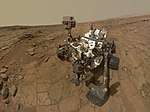Kepler-80
Kepler-80, also known as KOI-500, is a Red dwarf star of the spectral type M0V.[1] This stellar classification places Kepler-80 among the very common, cool, Class M stars that are still within their main evolutionary stage, known as the Main Sequence. Kepler-80, like other Red dwarf stars, is smaller than the Sun, and it has both radius, mass, temperatures, and luminosity lower than that of our own star.[2] Kepler-80 is found approximately 1,218 light years from the Solar System, in the stellar constellation Cygnus, also known as the Swan.
| Observation data Epoch J2000 Equinox J2000 | |
|---|---|
| Constellation | Cygnus |
| Right ascension | 19h 44m 27.0201s[3] |
| Declination | 39° 58′ 43.5938″[3] |
| Apparent magnitude (V) | 14.804 |
| Characteristics | |
| Spectral type | M0V[1] |
| Astrometry | |
| Proper motion (μ) | RA: −1.380±0.037[3] mas/yr Dec.: −7.185±0.046[3] mas/yr |
| Parallax (π) | 2.6780 ± 0.0210[3] mas |
| Distance | 1,218 ± 10 ly (373 ± 3 pc) |
| Details | |
| Mass | 0.730 M☉ |
| Radius | 0.678 R☉ |
| Luminosity | 0.170 L☉ |
| Temperature | 4540 K |
| Metallicity [Fe/H] | -0.56 [4] dex |
| Rotation | 25.567±0.252 days[5] |
| Other designations | |
| Database references | |
| SIMBAD | data |
| KIC | data |
The Kepler-80 system has 6 known exoplanets.[6][7] The discovery of the five inner planets was announced in October 2012, marking Kepler-80 as the first star identified with five orbiting planets.[8][2] In 2017, an additional planet, Kepler-80g, was discovered by use of Artificial Intelligence and Deep Learning to analyse data from the Kepler Space Telescope.[7] The method used to discover Kepler-80g had been developed by Google, and during the same study another planet was found, Kepler-90i, which brought the total number of known planets in Kepler-90 up to 8 planets.[9]
Planetary system
The exoplanets around Kepler-80 were discovered and observed using the Kepler Space Telescope. This telescope uses the so called transit method, where the planets move in between the star and the Earth and thereby dim the light of the star as seen from the Earth. By using photometry the transit of a planet in front of its star can be seen as a dip in the light curve of the star. After the initial discovery the five innermost planets have all been confirmed through additional investigations. Kepler-80b and Kepler-80c were both confirmed in 2013 based on their transit-timing variation (TTV).[10] Kepler-80d and Kepler-80e were validated in 2014 based on statistical analysis of the Kepler data.[11][12] Finally the innermost planet, Kepler-80f was confirmed in 2016.[12]
All six known planets in the Kepler-80 system orbit very close to the star, and their distances to the star (the semi major axes) are all smaller than 0.2 AU. For comparison the planet in the Solar System closest to the star, Mercury, has a semi major axis of 0.389 AU, and so the entire known system of Kepler-80 can lie within the orbit of Mercury.[13] This makes Kepler-80 a very compact system and it is one of many STIP's (Systems with Tightly-packed Inner Planets) that have been discovered by the Kepler telescope.[8]
In 2014, the dynamical simulation shown what the Kepler-80 planetary system have likely to undergone a substantial inward migration in the past, producing an observed pattern of lower-mass planets on tightest orbits.[14]
| Companion (in order from star) |
Mass | Semimajor axis (AU) |
Orbital period (days) |
Eccentricity | Inclination | Radius |
|---|---|---|---|---|---|---|
| f | — | 0.0175 ± 0.0002 | 0.98678730 ± 0.00000006 | ~0 | 86.50 +2.36 −2.59° |
1.21 +0.06 −0.05 R⊕ |
| d | 6.75 +0.69 −0.51 M⊕ |
0.0372 ± 0.0005 | 3.0722 +0.00006 −0.00004 |
~0 | 88.35 +1.12 −1.51° |
1.53 +0.09 −0.07 R⊕ |
| e | 4.13 +0.81 −0.95 M⊕ |
0.0491 ± 0.0007 | 4.6449 +0.00020 −0.00019 |
~0 | 88.79 +0.84 −1.07° |
1.60 +0.08 −0.07 R⊕ |
| b | 6.93 +1.05 −0.070 M⊕ |
0.0658 ± 0.0009 | 7.0525 +0.00020 −0.00022 |
~0 | 89.34 +0.46 −0.62° |
2.67 ± 0.10 R⊕ |
| c | 6.74 +1.23 −0.86 M⊕ |
0.0792 ± 0.0011 | 9.52355 +0.00041 −0.00029 |
~0 | 89.33 +0.47 −0.57° |
2.74 +0.12 −0.10 R⊕ |
| g | — | 0.142 +0.037 −0.051 |
14.64558 ± 0.00012 | — | 89.35 +0.47 −0.98° |
1.13 ± 0.14 R⊕ |
Orbital resonance
Kepler-80 d, e, b, c and g have orbits locked in a resonance. While their periods are in a ~ 1.000: 1.512: 2.296: 3.100: 4.767 ratio, in a frame of reference that rotates with the conjunctions this reduces to a ratio of 4:6:9:12:18. Conjunctions of d and e, e and b, b and c, and c and g occur at relative intervals of 2:3:6:6 in a pattern that repeats about every 191 days. Librations of possible three-body resonances have amplitudes of only about 3 degrees, and modeling indicates the resonant system is stable to perturbations. Triple conjunctions do not occur.[7][15]
References
- "Kepler-80". SIMBAD. Centre de données astronomiques de Strasbourg. Retrieved 10 January 2017.
- MacDonald, Mariah G.; Ragozzine, Darin; Fabrycky, Daniel C.; Ford, Eric B.; Holman, Matthew J.; Isaacson, Howard T.; Lissauer, Jack J.; Lopez, Eric D.; Mazeh, Tsevi (October 2016). "A DYNAMICAL ANALYSIS OF THE KEPLER-80 SYSTEM OF FIVE TRANSITING PLANETS". The Astronomical Journal. 152 (4): 105. arXiv:1607.07540. Bibcode:2016AJ....152..105M. doi:10.3847/0004-6256/152/4/105. ISSN 1538-3881.
- Brown, A. G. A.; et al. (Gaia collaboration) (August 2018). "Gaia Data Release 2: Summary of the contents and survey properties". Astronomy & Astrophysics. 616. A1. arXiv:1804.09365. Bibcode:2018A&A...616A...1G. doi:10.1051/0004-6361/201833051. Gaia DR2 record for this source at VizieR.
- "OASIS". Abstractsonline.com. Retrieved 2012-11-22.
- McQuillan, A.; Mazeh, T.; Aigrain, S. (2013). "Stellar Rotation Periods of The Kepler objects of Interest: A Dearth of Close-In Planets Around Fast Rotators". The Astrophysical Journal Letters. 775 (1). L11. arXiv:1308.1845. Bibcode:2013ApJ...775L..11M. doi:10.1088/2041-8205/775/1/L11.
- Xie, J.-W. (2013). "Transit timing variation of near-resonance planetary pairs: confirmation of 12 multiple-planet systems". Astrophysical Journal Supplement Series. 208 (2): 22. arXiv:1208.3312. Bibcode:2013ApJS..208...22X. doi:10.1088/0067-0049/208/2/22.
- Shallue, C. J.; Vanderburg, A. (2017). "Identifying Exoplanets With Deep Learning: A Five Planet Resonant Chain Around Kepler-80 And An Eighth Planet Around Kepler-90" (PDF). The Astrophysical Journal. 155 (2): 94. arXiv:1712.05044. Bibcode:2018AJ....155...94S. doi:10.3847/1538-3881/aa9e09. Retrieved 2017-12-15.
- Ragozzine, Darin; Kepler Team (2012-10-01). "The Very Compact Five Exoplanet System KOI-500: Mass Constraints from TTVs, Resonances, and Implications". Aas/Division for Planetary Sciences Meeting Abstracts #44. 44: 200.04. Bibcode:2012DPS....4420004R.
- St. Fleur, Nicholas (14 December 2017). "An 8th Planet Is Found Orbiting a Distant Star, With A.I.'s Help". The New York Times. Retrieved 15 December 2017.
- Xie, Ji-Wei; Wu, Yanqin; Lithwick, Yoram (2014-06-25). "FREQUENCY OF CLOSE COMPANIONS AMONGKEPLERPLANETS—A TRANSIT TIME VARIATION STUDY". The Astrophysical Journal. 789 (2): 165. arXiv:1308.3751. doi:10.1088/0004-637x/789/2/165. ISSN 0004-637X.
- Lissauer, Jack J.; Marcy, Geoffrey W.; Bryson, Stephen T.; Rowe, Jason F.; Jontof-Hutter, Daniel; Agol, Eric; Borucki, William J.; Carter, Joshua A.; Ford, Eric B. (2014-03-04). "VALIDATION OFKEPLER'S MULTIPLE PLANET CANDIDATES. II. REFINED STATISTICAL FRAMEWORK AND DESCRIPTIONS OF SYSTEMS OF SPECIAL INTEREST". The Astrophysical Journal. 784 (1): 44. arXiv:1402.6352. Bibcode:2014ApJ...784...44L. doi:10.1088/0004-637x/784/1/44. ISSN 0004-637X.
- Rowe, Jason F.; Bryson, Stephen T.; Marcy, Geoffrey W.; Lissauer, Jack J.; Jontof-Hutter, Daniel; Mullally, Fergal; Gilliland, Ronald L.; Issacson, Howard; Ford, Eric (2014-03-04). "VALIDATION OFKEPLER'S MULTIPLE PLANET CANDIDATES. III. LIGHT CURVE ANALYSIS AND ANNOUNCEMENT OF HUNDREDS OF NEW MULTI-PLANET SYSTEMS". The Astrophysical Journal. 784 (1): 45. arXiv:1402.6534. Bibcode:2014ApJ...784...45R. doi:10.1088/0004-637x/784/1/45. ISSN 0004-637X.
- "Mercury Fact Sheet". nssdc.gsfc.nasa.gov. Retrieved 2019-04-14.
- T. O. Hands, R. D. Alexander, W. Dehnen, "Understanding the assembly of Kepler's compact planetary systems", 2014
- MacDonald, Mariah G.; Ragozzine, Darin; Fabrycky, Daniel C.; Ford, Eric B.; Holman, Matthew J.; Isaacson, Howard T.; Lissauer, Jack J.; Lopez, Eric D.; Mazeh, Tsevi (2016-01-01). "A Dynamical Analysis of the Kepler-80 System of Five Transiting Planets". The Astronomical Journal. 152 (4): 105. arXiv:1607.07540. Bibcode:2016AJ....152..105M. doi:10.3847/0004-6256/152/4/105.
- "Kepler-80 g". NASA Exoplanet Archive. Retrieved 14 December 2017.
- "Kepler-80". NASA Exoplanet Archive. Retrieved May 9, 2018.


